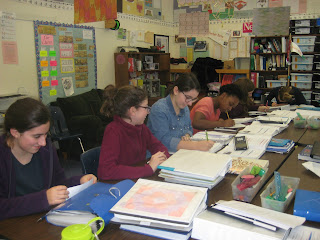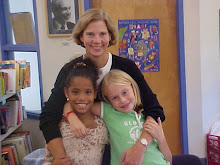Monday, May 22, 2017
Educating for Innovation: the essential elements
The panel of experts we assembled in April from RPI, SUNY College of Engineering, Regeneron, Ohio State and Tech Valley High agreed on certain elements of education that promote innovation. See what you think! https://haikudeck.com/p/cQ6T0IwPud
Friday, April 28, 2017
International friendships
Having friends visit from across the world is an incredibly exciting thing. Kids from Spain might never have tried peanut better or bagels - but it turns out they love them! They speak five languages - fluently! Different and the same - middle school kids are middle school kids.
We are so fortunate to have a partnership with St. Peter's School in Barcelona. One year they send a dozen students to us to stay with our families and the next year we send students to them. We get to exchange teachers, too.
Our students revel in visiting a school with a beautiful dining hall and scrumptious prepared food. They walk everywhere in Barcelona - to La Sagrada Familia and other Gaudi sites and they buy fruit and churros at the outdoor market. They can't believe that dinner starts after 9 PM!
St. Peter's students are amazed at sledding in the snow at Parker, our iconic yellow school buses, and dressing up on Halloween. Being at a school with woodsy trails and a pond is incredible. A campfire with roasted marshmallows on a stick and s'mores - Wow!
Together they go to classes and museums, they sing, create poems and art works - go bowling - and revel in being kids.
From the first year we made new friends from Spain, the entire student body at Parker became more motivated to master the Spanish language. We ended up extending Spanish to our Preschool and added another session of Spanish to the 4-5 weekly schedule. For one week a year, everyone plays and works together, getting to know new families and customs and practicing another language. Then it's time to leave.
This week went by so fast - and next year, our turn to visit in Spain, will be here before we know it.
Wednesday, April 5, 2017
Why should kids think like a computer?
Today in the NY Times, Laura Pappano, an education journalist writes about Learning to Think Like a Computer. It has become super popular lately to learn computer programming in college - and we see the excitement in elementary and middle school with robotics, Scratch and other programming activities.
Programming demystifies computing in many ways and gives kids practice in sequencing - the step by step brain work that is required to program successfully. "It's the idea of abstraction," Pappano quotes in her article. "It requires recognizing patterns and distilling complexity into a precise, clear summary,"
I see it in action in school through the intensity that kids bring to robotics - the perseverance they develop and the whoop of joy when they get the result they are looking for. They often work together, too and get a lot of practice collaborating when they are designing a 3D prosthetic limb for an amputee or adding voices to a life-story animation.
On days that we have after school robotics club, kids often come to show me what they've accomplished: in the photo above, a second and a third grader got their robot to stop at each color line and say "red", "blue"or "yellow". But it skipped saying "green"! Oh well - they weren't deterred - they went running back to the drawing board to try again.
Labels:
3D printer,
collaboration,
computing,
critical thinking,
robotics,
Scratch
Tuesday, April 4, 2017
Educating for Innovation
I am so excited for our panel discussion tomorrow night - innovators from UAlbany, RPI, Regeneron, Ohio State and Tech Valley High will be here to trade ideas about the hottest trend in education today.
From a Nobel prize winning astronomer who researches the Milky Way Galaxy to a Director of Regeneron Pharmaceuticals, named by Forbes as one of the most innovative companies in the US, we have assembled an impressive and highly interesting group. It should be a lively event!
Thursday, March 2, 2017
View from the Head's chair
Visits to my office by 3 and 4-year-olds is always a highlight. My Pre K friends came by yesterday on a pizza parade. It was an adorable invasion!
Tuesday, February 28, 2017
Helping teens cope with emotions
Teens and emotions - almost everyone says that middle school years are the hardest. Emotions during the early teens can be strong and confusing. And they can change on a dime. And the crazy thing is...that's normal!
Here is a great article from MindShift about teens and emotions - and how to help them cope. For teachers and parents both, talking with kids about the emotions and normalizing them is key.
For kids, knowing that they are not alone or strange really helps them deal with their changing and strong feelings. Some key things to remember, says Susan David, Harvard educator and author of Emotional Agility, are:
Emotions pass
Emotions are teachers
Courage is "fear walking"
Articulating values helps set an inner compass
Just having a caring adult to listen can help calm the strong emotions our teens are feeling. We can all do that!
Here is a great article from MindShift about teens and emotions - and how to help them cope. For teachers and parents both, talking with kids about the emotions and normalizing them is key.
For kids, knowing that they are not alone or strange really helps them deal with their changing and strong feelings. Some key things to remember, says Susan David, Harvard educator and author of Emotional Agility, are:
Emotions pass
Emotions are teachers
Courage is "fear walking"
Articulating values helps set an inner compass
Just having a caring adult to listen can help calm the strong emotions our teens are feeling. We can all do that!
Tuesday, February 7, 2017
Addicted to questioning
In a study of owls in K-1 the curiosity is palpable. Is this owl alive? How did it die? Why are the feathers so soft? Why is it called a barred owl, or a horned owl? How do the wings work? Can I touch it? The questions rule the day. Observational drawings come next. Students are developing the skill of noticing details. And asking even more questions. And then the teacher brings out...the owl pellets...!
In this article in MindShift, How to Bring More Beautiful Questions Back to School, Katerina Schwartz contends that after about age 5 or 6, questioning falls off. Yet a questioning mind is a highly desired skill in any modern work place - it's the value added in the technology age.
For questioning minds to thrive, children need lots of time - not a curriculum that "covers" material. They need a culture that rewards intellectual risk-taking - not one that penalizes wrong answers.
Effective teachers set up a topic and trigger questioning - then find ways to follow where kids' curiosity takes them. They allow for a deep dive into a juicy problem or topic. What's the result? A classroom filled with knowledge addicts - confident kids who crave to question and to learn more.
Wednesday, January 18, 2017
Teaching for creativity
His three main points are that values should take president over rules; that character is more important than behavior; and that giving kids examples from the books they read - of kids doing creative things that haven't been done before, are ways to develop creativity.
This is interesting to me. It speaks to the way we construct the school experience for our students and what we intend for them to gain from it. It is a question the Parker faculty is always trying to get to the root of - How do we develop creativity, empathy, and purpose in our students - skills that will serve them well for their entire lives?
We strive to inspire curiosity by posing interesting questions and by giving students the ways and means to explore the world around them and topics they become interested in. We set high expectations and let the children help develop rules, giving them the real responsibility (with adult support) to construct a kind and supportive community. We set up many experiences where learning has a purpose beyond the immediate classroom, by doing projects that have an impact on others: citizen science, teaching others, coming up with solutions to real world problems, community service. And everyone is immersed in the arts - music, dance, instruments, painting, dramatics, public speaking, design and many, many other creative practices.
We also give them time to play and to contemplate.
I like Grant's ideas and hope to expand even further on the question of developing creativity and innovators. On the evening of April 5 we are having a panel discussion, open to the public, about just this topic. We have some amazing thinkers lined up - Stay tuned - more information is coming!
Labels:
21st C skills,
adventure,
creativity,
purposeful action,
STEM
Friday, January 6, 2017
Developing STEMpathy
Disruptive technology surrounds us: self-driving cars, software that writes poetry, drones delivering packages...When machines are competing with people for thinking, what's a human to do?!
Thomas Freidman has been thinking about this, and in his recent article From hands to heads to the hearts he answers that humans have what computers don't - a heart. He writes that everyone needs STEMpathy to succeed in this new age.
The attributes that can't be programmed are the ones we must develop in school, like passion, character and a collaborative spirit. It is crucial to combine knowledge with heart to if we want students to thrive in the technical age we live in.
It's a reminder of the importance of Parker's core values and mission, the right ones for our age, or any age.
This morning five alumni from 2008 and 2013 visited for a panel discussion. Represented were an art teacher and a novelist, a future biochemist, a future biomedical engineer, and a budding labor relations specialist. Their empathy was evident and the values and advice they espoused were about the importance of being friends with people who want to make you better, building relationships with teachers, and finding activities, clubs and subjects that you feel passionate about. They are all serious about ideas and value learning over grades.
They loved the fun they had at Parker - playing in the stream and being outdoors. They valued the friends and teachers. The thesis project was defining and prepared them for writing everywhere, even in college. They learned to learn for learning's sake, and felt proud of it. These young adults were definitely skilled in STEMpathy.
Tuesday, January 3, 2017
A reading/running connection
There is lots of evidence that an active learning environment with time for physical activity, running and play helps children learn better. The mind-body-learning connection is powerful stuff! A new study from Finland shows that first grade children, especially boys, need time running around in order to learn to read. Sitting for longer periods doesn't help - it actually hinders reading and math development! Here is the article in Time.com : Boys Who Sit Still Have Harder Time Learning to Read.
Boys whose days were more sedentary when they were in first grade (a crucial year for learning to read) made fewer gains in reading in second and third grade.
I'm happy to note that Parker kids in the lower grades get a minimum of 60 to 75 minutes a day for actual recess, and there is also phys ed, Muddy Boots Club, time spent outdoors just for fun, movement in music and Spanish and not a lot of "seat time". It is a great argument for the adventure we are about to embark on -Winter Fridays - when everyone gets a change of pace for swimming, skiing, XC skiing, snow boarding, and movement. Active body - active mind!
Subscribe to:
Posts (Atom)




















